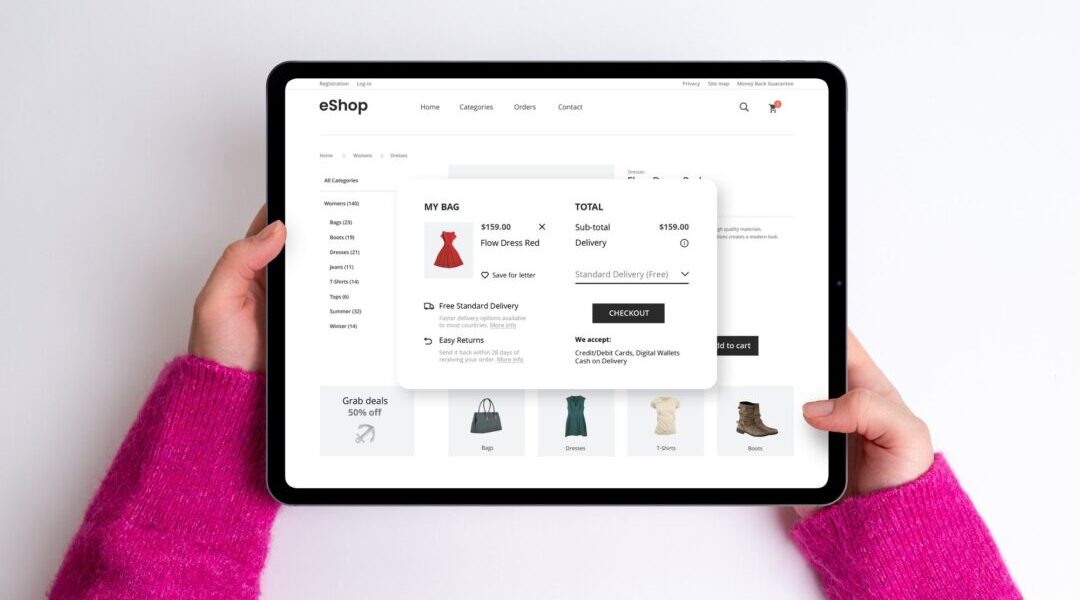Choosing the right eCommerce platform isn’t just a decision about design or software. It’s a strategic choice that can impact the success and growth of your business. A user-friendly and intuitive platform is integral to the user experience and can lead to higher conversion rates and customer satisfaction. From inventory management to payment processing, the features and capabilities of the platform directly affect your ability to scale and grow your online business.
The security and reliability of the platform are paramount in protecting both your business and your customers’ sensitive information. What’s more, an eCommerce platform that integrates seamlessly with your other business software and systems will enhance productivity, reduce labor hours, and provide valuable insights into your operations.
So, how do you know which platform is right for you? This guide breaks down four important steps in evaluating popular eCommerce platforms. In the end, you’ll be able to choose the best solution for your unique business needs.
1. Research
Before you can make a choice, you need to know what’s out there. Research different eCommerce platforms, what each has to offer, and how they compare. Key aspects to check include:
eCommerce Platform Cost
One of the first things most companies consider is the cost of running an eCommerce store. It’s important to weigh the upfront or monthly subscription fee against your budget. However, this isn’t necessarily an accurate indication of the platform cost.

As you research various platforms, compare what you pay to what you get in return. In addition to monthly subscription fees, take the following into account as you estimate eCommerce platform costs:
- Once-off fee for a premium website theme or design template
- Add-on features and plugins
- Customizations
- Hosting and SSL certificate
- Software developer services
Consider transaction fees as well. Some platforms may have lower initial costs but require paid add-ons and have higher transaction fees. Others may seem costly but offer more inclusive features and lower transaction fees.
Sales and Advertising Channels
Integrating with various sales and advertising channels is a highly effective way to attract new customers. Ensure the platform supports integration with popular marketplaces such as Amazon, Google Shopping, and eBay, as well as social media sales channels like Facebook, Instagram, TikTok, and Pinterest. Leveraging these platforms enables you to capitalize on diverse sales opportunities.
Product Inventory Features
Evaluate each platform’s product limits and the complexity of product inventory features. It should be able to support growth and streamline inventory management across various sales channels. The capacity of the platform to support your full product range will directly impact your ability to showcase and sell your products effectively.
Robust inventory management features, such as batch editing, automated reordering, and real-time tracking, can streamline your processes and reduce the likelihood of errors. What’s more, advanced features like customizable product attributes, bundling options, and inventory forecasting can give you a competitive edge and enhance the overall shopping experience for your customers.
Search Engine Optimization
Selecting an eCommerce platform with robust search engine optimization (SEO) features can enhance your website’s ranking, drive more traffic, and boost sales.
When you assess eCommerce platforms for SEO, consider the ability to create search-friendly URLs and manage metadata effectively. Customizable metadata such as title tags, meta descriptions, and header tags help improve search result visibility.
Payment Gateway Options
Allowing customers to pay in the way that suits them can significantly improve sales. Research the supported payment gateways and methods as well as available options for international sales. Also see if the platform charges an extra fee (in addition to the transaction fee) for using external payment gateways. This can eat into your profits.
Mobile Responsiveness
With a large portion of online shopping occurring on mobile devices, your eCommerce platform must offer a smooth mobile experience. The platform should have mobile optimization features and allow for easy navigation on different screen sizes.

In addition, functionalities like mobile-friendly checkout processes and responsive design elements should be considered to create a user-friendly shopping experience. Prioritizing mobile responsiveness will help you reach a wider audience and drive more conversions.
eCommerce Platform Security
Security is a critical consideration. Enterprise eCommerce platforms should offer robust security features to protect your business and customer data. Look for features such as:
- A secure and reliable payment processing system
- SSL encryption
- Payment card industry (PCI) compliance
- Two-factor authentication
- Fraud detection and protection against DDoS attacks
- Regular automated backups and firewalls to prevent malware and hacking incidents
Platform Support
Ensure the platform offers sufficient customer support, including technical assistance, documentation, and tutorials. eCommerce platforms should undergo regular updates to fix security vulnerabilities, defend against potential attacks, and maintain peak performance.
2. Evaluate eCommerce Platform Features
Every business has different needs. While an eCommerce platform may have remarkable features, it doesn’t help if they’re not specific to what your business requires.
Now that you know what each platform can provide, match up the features to your unique needs and budget. Consider the following:
Ease of Use
The user-friendliness of an eCommerce platform ensures smooth operations and a positive shopping experience for both customers and administrators. A platform that’s intuitive and easy to navigate can reduce the learning curve for your team. It also minimizes the likelihood of errors as you manage the online store.
Consider factors such as the platform’s dashboard layout, menu structures, and customization options that cater to varying levels of technical expertise. Whether you have a dedicated developer team or rely on your own technical skills, choosing a platform that aligns with your comfort level can impact the efficiency of day-to-day tasks and contribute to the success of your online business.
Customization and Flexibility
A platform that allows you to customize your website’s design, content, and layout can help you create a unique brand experience that stands out from the crowd. Consider whether you can tailor the platform to fit your business needs, such as customizing the checkout process and adding new features.
Integration With Other Software
Evaluate the ability to integrate the eCommerce platform with the software you already use. This may include marketing tools, inventory management, accounting, product information management (PIM), and shipping.

The ability to synchronize and streamline business functions will significantly reduce the time and resources needed to manage your online store. It also minimizes errors and improves efficiency.
eCommerce Platform Scalability
Determine whether the platform can grow alongside your business. Can the platform handle higher volumes of traffic and sales without affecting site performance or user experience? Consider factors such as multi-language support, ease of adding plugins, and the capacity to maintain seamless shop performance with a large number of items.
Also, take into account whether you can add additional sales channels as your business expands. If you’re a B2C brand, see if you can incorporate wholesale selling options. If you’re a B2B brand, are there ways to enter the B2C market at a later stage?
3. Look Into an Alternative eCommerce Platform
If you’ve only researched popular SaaS platforms and haven’t found an eCommerce solution that perfectly fits your business needs or budget, don’t stop there. Look beyond mainstream one-size-fits-all models and consider open-source and hybrid solutions.
Although these options require more technical expertise than done-for-you solutions, they offer a much greater level of customization. Depending on your requirements and technical skills, they can also be a cost-effective option.
4. Consider Future Development
When choosing an eCommerce platform, remember that things will evolve in the future. This applies to your business, your customers, and industry trends. As consumer trends and preferences change, you need to be adaptable to remain relevant. Here are some points to consider:
- Contract Length: Enterprise eCommerce platforms often require a two- to three-year commitment. Other plans generally offer a month-to-month option with a discount if you’re billed every year or two. But if you decide to stop using the platform before your billing period ends, you won’t get a refund for the remaining months.
- Rebranding: Not all platforms allow you to change your store theme once you’ve chosen it. This means rebranding, merging, or simply changing your eCommerce website design in the future might not be as simple as selecting a different template.
- Business Expansion: Some platforms limit the number of inventory locations you can integrate. They also limit staff accounts, cap sales, and have a listing threshold. Make sure the platform won’t hinder your business growth. Also, see if there are extra fees as your sales or product quantities increase.
- New Features: Can the platform integrate new trending features that will benefit your business? Technology is continually evolving, and you need to stay on top of the latest digital trends and consumer interests.
Strategizing for Success With Your eCommerce Platform
When choosing an eCommerce platform, you must understand the advantages and drawbacks of each approach. Assess the complexities and differences of eCommerce models to develop a strategy that improves customer experiences, boosts growth, and adjusts to changing market demands.
For instance, Salesforce Commerce Cloud excels in creating personalized customer experiences, while Adobe Commerce Cloud is renowned for its flexibility and integration capabilities. Shopify Enterprise provides an intuitive and user-friendly interface to rapidly scale operations.
Our award-winning team at Zobrist Software Group, Inc. is behind the eCommerce development of many of today’s leading online brands. We can help you compare top platforms in detail to identify which will best support your business objectives, budget, and operational needs.
At Zobrist, we go beyond the ordinary to create advanced eCommerce shopping experiences with the newest commerce, analytics, and payment technologies. Need a managed eCommerce solution? Let’s chat about your options.




